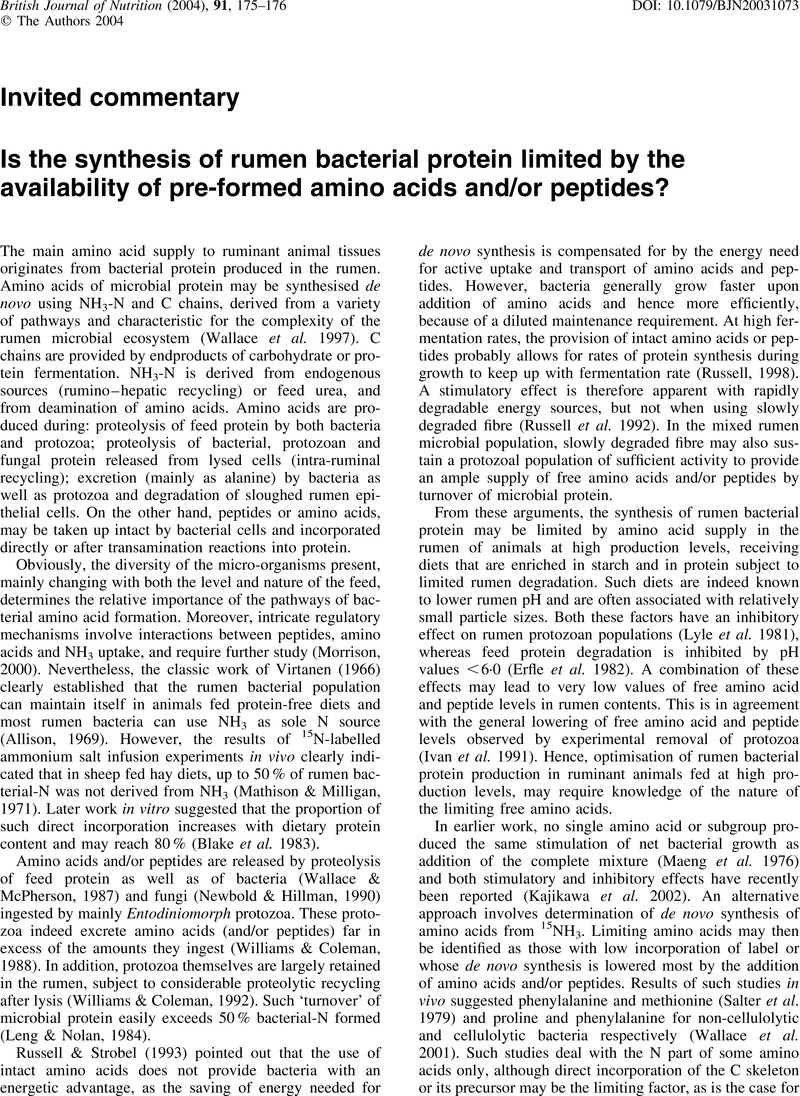Crossref Citations
This article has been cited by the following publications. This list is generated based on data provided by Crossref.
Guliye, A. Y.
Atasoglu, C.
and
Wallace, R. J.
2005.
Assessment of amino acid requirements for optimum fermentation of xylan by mixed micro-organisms from the sheep rumen.
Animal Science,
Vol. 80,
Issue. 3,
p.
353.
Bach, A.
Calsamiglia, S.
and
Stern, M.D.
2005.
Nitrogen Metabolism in the Rumen.
Journal of Dairy Science,
Vol. 88,
Issue. ,
p.
E9.
Boguhn, J.
Kluth, H.
and
Rodehutscord, M.
2006.
Effect of Total Mixed Ration Composition on Fermentation and Efficiency of Ruminal Microbial Crude Protein Synthesis In Vitro.
Journal of Dairy Science,
Vol. 89,
Issue. 5,
p.
1580.
KAJIKAWA, Hiroshi
TAJIMA, Kiyoshi
MITSUMORI, Makoto
and
TAKENAKA, Akio
2007.
Inhibitory effects of isoleucine and antagonism of the other branched‐chain amino acids on fermentation parameters by mixed ruminal microbes in batch cultures and rumen simulating fermenters (Rusitec).
Animal Science Journal,
Vol. 78,
Issue. 3,
p.
266.
KAJIKAWA, Hiroshi
TAJIMA, Kiyoshi
MITSUMORI, Makoto
and
TAKENAKA, Akio
2007.
Effects of amino nitrogen on fermentation parameters by mixed ruminal microbes when energy or nitrogen is limited.
Animal Science Journal,
Vol. 78,
Issue. 2,
p.
121.
Cole, N. A.
and
Todd, R. W.
2008.
Opportunities to enhance performance and efficiency through nutrient synchrony in concentrate-fed ruminants1,2,3.
Journal of Animal Science,
Vol. 86,
Issue. suppl_14,
p.
E318.
SENG, M.
BONORDEN, S.
NISSEN, J.
ISSELSTEIN, J.
and
ABEL, H.
2008.
Fermentation patterns and nutrient contents of forb-containing silages and their effects on microbial fermentation in the artificial rumen system RUSITEC.
The Journal of Agricultural Science,
Vol. 146,
Issue. 3,
p.
333.
Hildebrand, B.
Boguhn, J.
and
Rodehutscord, M.
2011.
Effect of maize silage to grass silage ratio and feed particle size on protein synthesis and amino acid profile in different microbial fractions in a semi-continuous rumen simulation.
Animal,
Vol. 5,
Issue. 4,
p.
537.
Han, Xufeng
Li, Bibo
Wang, Xiaolong
Chen, Yulin
and
Yang, Yuxin
2019.
Effect of dietary concentrate to forage ratios on ruminal bacterial and anaerobic fungal populations of cashmere goats.
Anaerobe,
Vol. 59,
Issue. ,
p.
118.
Carter, Wales A.
Bauchinger, Ulf
and
McWilliams, Scott R.
2019.
The Importance of Isotopic Turnover for Understanding Key Aspects of Animal Ecology and Nutrition.
Diversity,
Vol. 11,
Issue. 5,
p.
84.
Peng, Xiao-Pei
Nie, Cunxi
Guan, Wen-Yi
Qiao, Li-Dong
Lu, Lin
and
Cao, Shou-Jun
2020.
Regulation of Probiotics on Metabolism of Dietary Protein in Intestine.
Current Protein & Peptide Science,
Vol. 21,
Issue. 8,
p.
766.
Liu, En
Xiao, Weiwei
Pu, Qijian
Xu, Lanjiao
Wang, Long
Mao, Kang
Hong, Wei
Qu, Mingren
and
Xue, Fuguang
2022.
Microbial and metabolomic insights into the bovine lipometabolic responses of rumen and mammary gland to zymolytic small peptide supplementation.
Frontiers in Veterinary Science,
Vol. 9,
Issue. ,
Liang, Jing
Du, Baolong
Wan, Minyan
Sun, Likun
Qin, Shizhen
Nian, Fang
and
Tang, Defu
2024.
Effects of L-Leu-L-Leu peptide on growth, proliferation, and apoptosis in broiler intestinal epithelial cells.
Poultry Science,
Vol. 103,
Issue. 5,
p.
103582.



